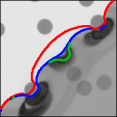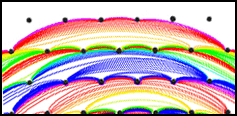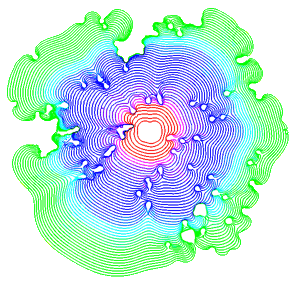|
|
Research
|
Microfluidics
is an emerging cross-disciplinary field that offers many
opportunities for scientific and technological advancements.
The laboratory's
research interests include the development
and application of methods to produce and control soft and reactive
interfaces at
the microscale. To this end, various aspects of interfacial fluid
dynamics and hydrodynamics are
examined in silicon and glass microfluidic modules using high-speed
imaging.
Investigations focus on the
control of viscous
and capillary instabilities of microflows in simple and complex
geometries. Research
areas span between
advanced micro-fabrication techniques,
multiphase flows, wetting dynamics, miscible flows, and the rheology
of complex fluids.
|
|
Microfluidic
Multiphase Flows
Multiphase
flows are encountered in a wide
range of applications including chemical, petroleum, and power
generation
industries. Miniaturization of fluidic devices makes it possible to
control fluids streams, droplets, and bubbles in a way that is
unprecedented. The
understanding of multiphase flow at the microscale not only
provides fundamental scientific insights but also offers new
functionalities for
practical uses. |
Miscible flows
The
precise manipulation of miscible fluids with large viscosity
contrast flowing co-currently at the microscale is
an
important challenge in science and engineering.
Passive
and active
methods are investigated to enhance mixing
between laminar fluid streams. Examples of application include the
enhancement of chemical reactions between widely disperates species,
such as between viscous material, including complex fluids, and less
viscous fluids, including solvent. |
Heterogeneous
viscous flow
|
Immisicible
flows
Droplets
and
emulsions: Microfluidic
systems provide the
advantage of generating arrays of droplets and bubbles with a high
degree of
monodispersity. Droplets can be created one-by-one at the junction of
cross-channels. We study the influence of flow
geometries and fluid thermodynamical properties on the collective
behavior and the hydrodynamic coupling of droplets in the presence and
in
the absence of surfactant.
|
Droplets
collective
behavior
|
Emulsion
flow patterns
|
Bubbles
and foams:
The
conditions for bubble formation, displacement, coalescence, packing,
and
separation from continuous phase are investigated with silicon and
glass microchannels in the
presence of surface modifications
(hydrophilic and hydrophobic surfaces) as well as with the addition of
particulates.
|

Flowing bubble partially
drying
microchannel walls |

Transport of
bubbles in square microchannels
|
|
Wetting
and dewetting
The motion of a contact
line
(fluid/fluid/solid interface) often takes place on a non-ideal surface.
Surface modifications
and patterning allow for manipulating advancing and receding contact
line dynamics, which can be used to confine and displace minute amount
of fluid on a surface.

Contact
line
edge detection
|

Faceted drop
growth on
periodically
patterned surfaces
|
|

Spontaneous
dewetting on
a heterogeneous surface
|
|
|
|
|
|